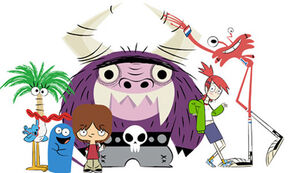Foster's Home for Imaginary Friends is a show created by Craig McCracken, best known as the creator of The Powerpuff Girls. The show premiered on August 13, 2004, and ended on May 3, 2009; McCracken chose to end the show because of its declining popularity. Throughout its run, Foster's earned a bevy of awards and nominations, including seven Emmy Awards and five Annie Awards out of 35 total nominations.
This show was being started as Craig McCracken was ready to cancel The Powerpuff Girls. Craig McCracken had used the Powerpuff Girls in several ways for Foster's Home, most notably the character of Mojo Jojo seen in the film House of Bloo's (Episode 1) as a "unimaginary friend", but we never saw Mojo Jojo's imagined copy ever again. Also, for the credits for "House of Bloo's", you can hear the Power Puff Girls theme while Bloo is watching TV in the top area on his bed.
All 6 seasons of Foster's can be either rented or bought on iTunes.
Overview
The series is set in an alternate reality in which childhood imaginary friends coexist with humans. In the show's universe, imaginary friends take physical form and become real as soon as children think them up. Once children outgrow them, friends are relocated to the titular orphanage, where they stay until other children adopt them. The home is run by the elderly Madame Foster, its lovable, kind founder; her imaginary friend Mr. Herriman, the strict rule-abider and business manager; and her granddaughter Frankie, who handles day-to-day operations.
Production
The series was created by Craig McCracken, who had also created The Powerpuff Girls for Cartoon Network Studios. McCracken developed the idea for the series after adopting two dogs from an animal shelter with his then-fiancéeLauren Faust; he adapted the concept of pet adoption to that of imaginary friends.[11] The show has an art style which is meant to evoke, according to McCracken, "that period of late 60's psychedelia when Victorian stylings were coming into trippy poster designs". McCracken wanted Foster's to be similar to The Muppet Show, which he believed was a "fun, character driven show that the whole family could enjoy".
Animation for the show was done using a process involving Adobe software Illustrator, Flash and After Effects.[14] McCracken directed, executive produced and story edited the series. Most of the episodes were produced at the Cartoon Network Studios in Burbank, California, while the rest were produced at Boulder Media in Dublin, Ireland.[14][15] The theme song was composed by James L. Venable, who had originally collaborated with McCracken on The Powerpuff Girls.[14] Craig described the music as "psychedelic ragtime".[11]Additional music was composed by Venable and Jennifer Kes Remington.[16]
Collette Sunderman was the casting and recording director for the show.[14][16] Sean Marquette was cast as Mac, and Keith Ferguson was cast as Bloo. The Powerpuff Girls voice actors Tom Kane, Tom Kenny and Tara Strong were cast in Foster's as Mr. Herriman, Eduardo and Terrence, respectively. Grey DeLisle was cast as Frankie Foster, and Candi Milo was cast as Coco and Madame Foster. From season two onwards, Milo also lent her voice to Cheese. DeLisle also voiced Goo after the character's debut in season three.
Characters
Main article: Foster's Home for Imaginary Friends/Characters

The main characters of the show. From left to right: Coco, Bloo, Mac, Eduardo, Frankie Foster, and Wilt
Episodes
Main article: Foster's Home for Imaginary Friends/Episodes
The show spanned seventy-nine episodes and six seasons; it has also aired eighteen shorts.
Merchandising and media
Video games
There are two video games based on Foster's Home for Imaginary Friends. The first has the same name as the show and was developed by Crave Entertainment for the Game Boy Advance. It was released on October 17, 2006. In the game, players control Mac or Bloo while collecting items to complete objectives. Jack Devries of IGN rated it a 5.5 out of 10, stating that it "falls short" and is "skippable". The second game, titled Foster's Home for Imaginary Friends: Imagination Invaders, was released on November 12, 2007, for the Nintendo DS by Midway. In the game, the player controls Bloo, who performs tasks and completes quests while fighting against "Space Nut Boogies". Devries rated it 4 out of 10, calling it "terrible to play" and "completely worthless". Characters from the show also appear on the games Cartoon Network: Punch Time Explosion andFusionFall.
On May 15, 2006, Cartoon Network introduced an online game, Big Fat Awesome House Party, which allowed players to create an online friend to join Bloo and the others in a one-year game online, earning points that would give them gifts, cards and other on-line "merchandise" for their albums. A player's friend, made from one of over 900,000 possible characters, could wind up in a future episode of Foster's. Over 13 million users were registered to play the game after its launch in May 2006. Because of its success and popularity, Cartoon Network announced in May 2007 that the game would continue for six more months, into November of that year.
